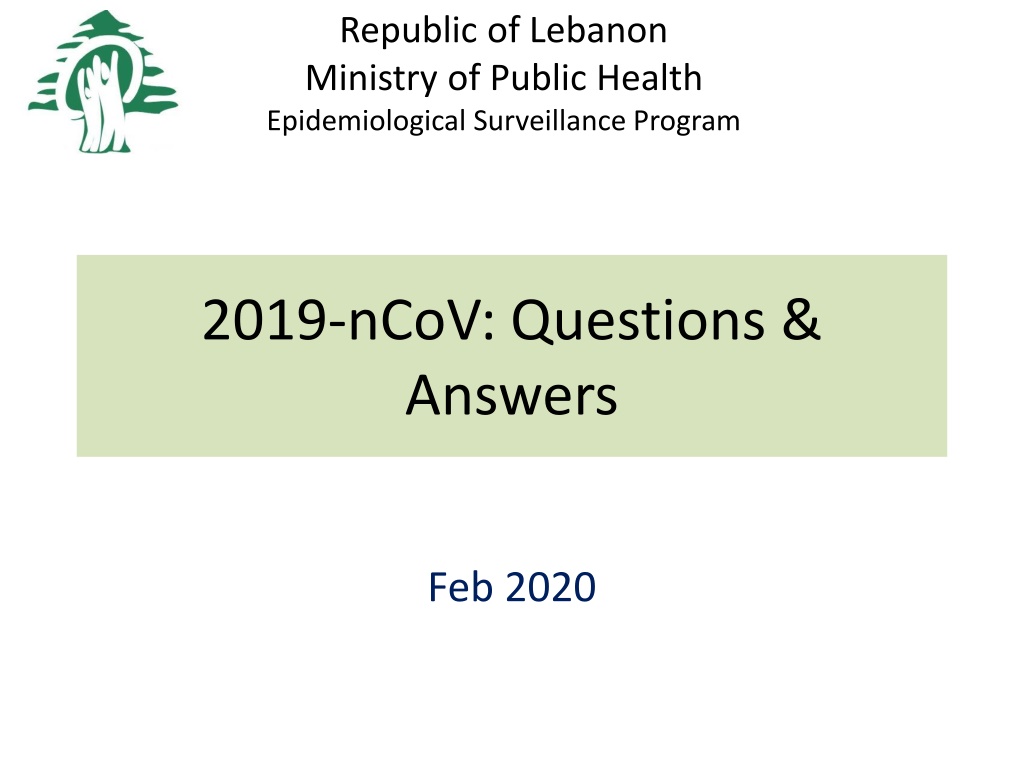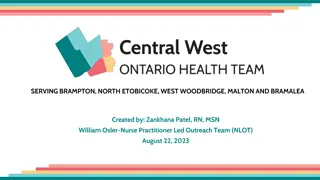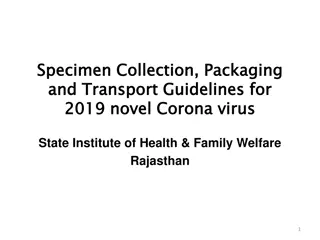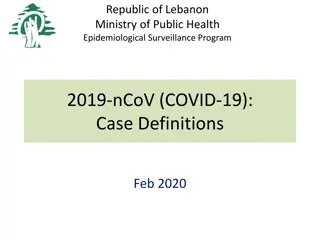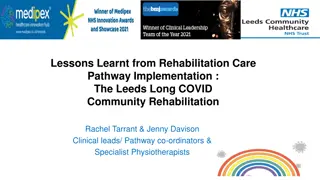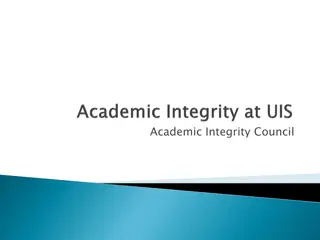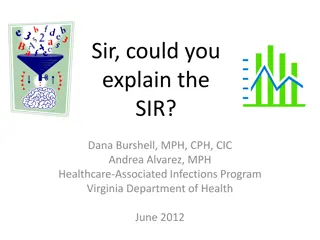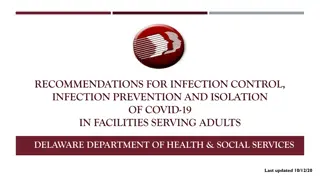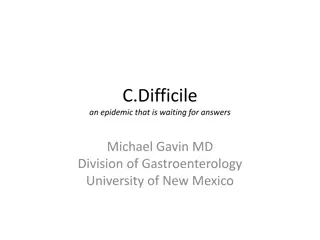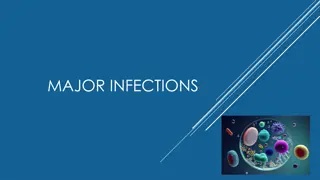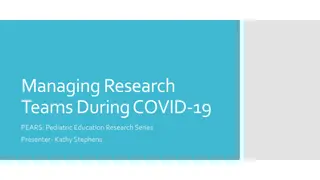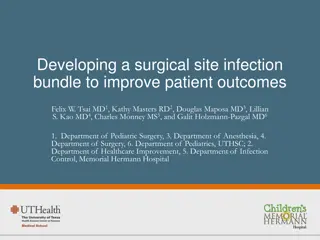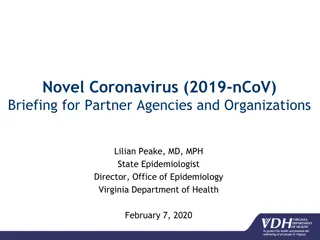Guidelines for Suspecting and Managing 2019-nCoV (COVID-19) Infection
Guidelines provided by the Ministry of Public Health in Lebanon highlight the criteria for suspecting a 2019-nCoV (COVID-19) infection, including illness onset and exposure factors. It outlines symptoms to look for, such as fever and respiratory issues, as well as exposure scenarios like travel to China or contact with confirmed cases. The document advises on what to do if suspicion arises, emphasizing infection control measures and the importance of consulting hospital emergency rooms for proper assessment and management. Additionally, it details infection control measures to protect contacts and stresses the significance of prior consultation with hospitals to prepare for potential cases. The ultimate goal is to assess health conditions and exposure to effectively manage potential cases of 2019-nCoV.
Download Presentation

Please find below an Image/Link to download the presentation.
The content on the website is provided AS IS for your information and personal use only. It may not be sold, licensed, or shared on other websites without obtaining consent from the author. Download presentation by click this link. If you encounter any issues during the download, it is possible that the publisher has removed the file from their server.
E N D
Presentation Transcript
Republic of Lebanon Ministry of Public Health Epidemiological Surveillance Program 2019-nCoV: Questions & Answers Feb 2020
When suspecting 2019-nCoV (COVID-19) infection? To suspect 2019-nCoV infection (COVID-19), we need to have: Illness onset Exposure
When suspecting 2019-nCoV (COVID-19) infection? Illness includes: Fever (38 and above) Respiratory symptoms: cough, coryza, sneezing, dyspnea
When suspecting 2019-nCoV (COVID-19) infection? Exposure includes in the 14 days prior to illness onset: Travel to China Contact with confirmed case Working in healthcare facility who had severe acute respiratory infection with unknown etiology
What to do in case of suspicion? If infection is suspected, there is need to: Implement infection control measures Call and consult Hospital ER
What are the infection control measures? Why? Measures to protect the contacts They include: Using medical mask Repetitive hand washing Avoid hand contact with eye, nose and mouth Avoid touching others Keep a distance of 2 meters with others Respect cough etiquette
Best way to consult Hospital ER Before consulting hospital ER, there is need to call them WHY? To conduct preliminary assessment of the exposure Prepare the reception of the patient with high enhanced infection control measures
Why consulting hospital ER? The aims to consult Hospital ER, are the following: To assess the health condition To assess the exposure to 2019-nCoV
Why consulting hospital ER? Assessment of health status: Severity and needs for hospital admission Assessment of exposure: Search of exposure conditions as mentioned in the case definition
What to do if matching the case definition? Is suspected case, then Enhanced infection control measures Notification to the MOPH Clinical specimen collection
What to do if confirmed case? If case is confirmed, then there is need to: Ensure needed case management Ensure high infection control practice including isolation Identify and follow up contacts including quarantine The MOPH will notify the case to WHO and to the public
Where confirmed cases are managed? Confirmed cases are to be treated in hospital settings With high infection control measures to prevent secondary cases
What are needed infection control practices? Infection control measures include: Patient isolation up to remission Standard, contact and droplets precautions Airborne precautions are requested in case of aerosol generating procedures
What are needed infection control practices? Infection control applied by the patient: Cough etiquette, hand hygiene, use medical mask, avoid distance less than 2 m with others Infection control applied by the contacts: Hand hygiene, avoid hand touching eye, nose and mouth, avoid contact with ill persons (at least 2 m distancing), use medical masks when in contact with ill persons Infection control applied by the healthcare workers: Use of personal protective equipment
How to use medical mask? Medical mask is used by: Patient: to cover his/her respiratory droplets Contact: to protect himself/herself from patient droplets
How to use medical mask? For efficient use of medical mask, there is need to respect the following: Wash hands before putting medical mask Put the mask and adjust it on the nose and mouth Avoid hand touching the external part of the mask When removing it : via the edges/ties and avoid touching the front portion Then wash hands
How to use medical mask? Medical mask is to be changed when wet Medical mask is single use material
How virus is transmitted? 2019-nCoV transmission is done as follow: From human to human: Mainly via droplets (when talking, coughing, sneezing), by direct or indirect ways Can be airborne in case of aerosol generating medical procedures From animal to human: in Wuhan city
How virus is transmitted? Incubation period: Time interval between virus entry to illness onset Usually 2 to 11 days (up to 14 days)
How virus is transmitted? Transmissibility period: Time interval when the patient can transmit the virus During illness with respiratory symptoms
Who are close contacts? Close contacts include: Health care workers giving care to the patients Co-workers / classmates in same office / room Travelers with the patient Household contacts
How contacts are monitored? Quarantine Monitoring by MOPH searching for any fever and respiratory symptoms In case of illness Isolation Health assessment Clinical specimen collection to be tested for 209- nCoV
